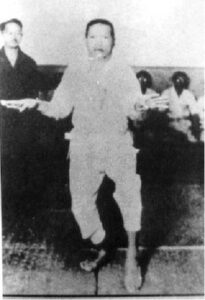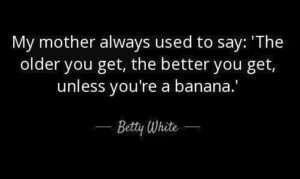Gichin Funakoshi once said:
“To search for the old is to understand the new. The old, the new, this is a matter of time. In all things, man must have a clear mind“.
Why Martial Arts Students Seek the Old: A Quest for Original Kata.
In the world of martial arts, the search for the original, untouched versions of kata is a quest that has intrigued many practitioners. There are two primary motivations behind this pursuit, each shedding light on the mindset of martial artists who embark on this journey.
Genuine Historical Curiosity.

Kenwa Mabuni observing in the background.
First and foremost, some martial artists are genuinely driven by historical curiosity. They yearn to delve into the past, seeking to uncover the earliest forms of kata. This quest for historical authenticity is marked by a sincere desire to understand the roots of their martial art. They wish to experience what the ancient practitioners might have practiced, providing a legitimate reason for their quest. Exploring the historical context can be a fascinating journey, offering insights into the evolution of martial arts over time.
The Assumption of Age as Superiority.

Another driving force behind the search for the original lies in the assumption that older must equate to better. It’s a belief deeply ingrained in many martial artists’ minds – the notion that the older a kata is, the more superior and pure it must be. However, this assumption does not necessarily hold true. The age of a kata does not automatically make it superior. Over time, martial arts techniques, like all aspects of human endeavor, can either improve or decline. Therefore, the belief that older is inherently better requires a critical reevaluation.
This fixation on the original version can be traced back to modern karate, where the three pillars of practice – kihon (basics), kata (forms), and kumite (sparring) – are treated as separate disciplines, each with its own set of rules and forms. In this context, debates often rage about the “correct” way to perform techniques. Should a shuto-uke (knife-hand block) have an elbow angle of 90 degrees or 135 degrees? Should the elbow touch the body or remain free? In the world of modern sport karate, rigid rules dictate what’s right and wrong.
The Myth of the Unchanged Originals.
However, one must question whether these original versions, often sought after with great fervor, even truly exist. The reality is doubtful. Kata creators seldom adhered strictly to their initial drafts. Kata evolved as they adapted to various situations and students. In some cases, instructors passed down their preferred variations, leading to multiple versions. The elusive “original” likely never existed in the form we imagine it.
Traditional kata within various schools and styles indeed undergo changes over time, but these changes do not necessarily make them worse. Different lineages may prefer slightly varied interpretations of the same fundamental principles. Athletic and aesthetic modifications may occur, but these alterations are often subtle and do not fundamentally undermine the essence of the kata.
Changes may also arise from simplifying movements to enhance instructional clarity, yet this typically does not compromise the kata’s core principles. Kata serve as templates; they are adaptable to different situations and applications.
In essence, the relentless quest for a historically pure, untouched original version is a futile endeavor. Rather than obsessing over historical accuracy, the primary question should revolve around whether the kata, in its current form, serves its intended purpose in training.
Traditional kata holds immense value as repositories of knowledge, aiding in solo practice, visualization, and body awareness. Even as they have evolved over time, they continue to fulfill their traditional roles. For those who continue to seek historical insight, an effective approach involves comparing modern versions to identify shared elements.
In conclusion, martial artists should prioritize a kata’s functional aspects over its historical details. Pursuing combative function aligns with the original intentions of martial arts masters. The focus should be on the bigger picture within the broader training context. The quest for the original should be a pursuit of understanding and improvement rather than an elusive relic of the past.
Thank you for taking the time to read my article.
Gert
